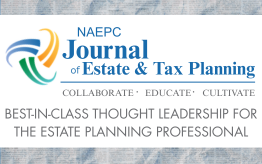August, 2011 Newsletter
Provided by Leimberg Information Services
See other issues.
Owen Fiore on Giustina V. Commissioner
"The opinion of Tax Court Judge Morrison in the Giustina FLP estate tax case provides detailed review and analysis of valuation methodologies applied to an active timberland business operated in limited partnership form. The court liberally exercised its power and tradition to accept, reject or modify valuation conclusions advanced by expert valuation appraisers.”
In Estate Planning Newsletter #1829, Paul Hood was LISI’s leadoff batter on the Giustina case. Owen Fiore, who often has commented for LISI on FLP and valuation cases, now comes to the plate in the clean-up position.
Owen Fiore, JD, is a long-time LISI commentator who presently has a family wealth planning consulting practice based in Idaho. He also provides continuing professional education seminars both online and at conferences and seminars. See www.owenfiore.com. In his commentary, Owen reviews the Giustina opinion and considers issues that might be raised with the value determinations of the court.
Now, here is Owen’s commentary:
EXECUTIVE SUMMARY:
Natale Giustina died in August, 2005 at age 87, a resident of Eugene, Oregon. He was survived by his wife and three children, one of which, Larry Giustina, was his executor and successor trustee as well as being the principal manager of the family limited partnership at issue. Giustina Land & Timber Co. (GL&T) owned approximately 48,000 acres of actively managed timberland in the area of Eugene, Oregon at decedent’s death. The estate tax value of decedent’s 41.128% GL&T limited partner interest is the sole substantive issue in this case, with IRS having proposed a $12.7 million estate tax deficiency, together with an IRC Section 6662 accuracy-related penalty of $2.5 million.
With the 90-year operating history of timberland farming in the Giustina Family and the formation of GL&T in 1990 as the result of a family entity reorganization, IRC Sections 2036 and 2038, often involved in FLP estate tax cases, were not issues here. So we have for review a pure valuation case, which allows for consideration of the role of expert appraisers, the broad authority of the court in reaching its own value determinations, and even possible issues on appeal. Two well-qualified appraisers with extensive trial testimony experience were involved, namely, (1) For the Service: John Thomson, Klaris Thomson & Schroeder, and (2) For the Estate: Robert Reilly, Willamette Management Associates. It would have been interesting to watch these appraisers at trial carrying out their duties to inform the court and to avoid being advocates for their respective clients!
Judge Morrison provided helpful charts explaining the parties’ positions and then setting forth his value conclusions. The court essentially weighted an income stream cash flow methodology with an asset sale methodology. Interestingly, the court expressly disregarded any market or “guideline company” approach, even though both appraisers opined on such! The weighting of the cash flow approach (75%) and the asset sale approach (25%) – especially with the asset sale analysis yielding three times current dollars over the present value of cash flows – may well be the subject of appellate review.
John Thomson, on behalf of the Service, argued for a 60% weighting of an asset sale “probability”, while the taxpayer’s expert, Robert Reilly, firmly stated that sale of assets is not to be considered where the estate had only a non-controlling (minority) interest in the entity. The numbers show how this played out: the Reilly conclusion of value for the decedent’s FLP interest was $13 million, the Thomson conclusion of value was $33.5 million. Judge Morrison, giving credence to the asset sale approach as a “25% probability” (with no discussion of evidence supporting such a conclusion), came up with $27.5 million. Query: Might not this conclusion by the court violate the hypothetical party standard of value in gift and estate tax cases?
The opinion of Tax Court Judge Morrison in the Giustina FLP estate tax case provides detailed review and analysis of valuation methodologies applied to an active timberland business operated in limited partnership form. The court liberally exercised its power and tradition to accept, reject or modify valuation conclusions advanced by expert valuation appraisers. Tax practitioners and appraisers can learn valuable lessons from the Giustina opinion, including, of course, the risks of litigation and uncertainty of result involved in proceeding to trial in the Tax Court.
FACTS:
This valuation case involves a non-controlling limited partnership interest in GL&T, and valuation of this partnership interest is the sole substantive issue. It is to be noted at the outset that the revocable trust of the decedent provided that 49% of such GL&T interest would go to his wife and thus qualify for a marital deduction.
The Giustina Family Business – Active Timberland Farming & Management.
The beginning of the Giustina Family business operations go way back to 1917 with the father of the decedent and two of the father’s brothers entering the timber/lumber industry in Oregon. Several entities were used to operate the business, which was located around Eugene, Oregon. The court’s opinion goes into detail about the entities, as well as reporting the eventual sales of lumber mills and the 1990 division of Giustina Family properties and businesses among family members. It is clear from the opinion that the Giustina Family valued long-term continuation of timberland farming operations.
One of the new entities formed in 1990 was GL&T, and the value of the 2005 41.128% limited partner interest of Natale Giustina in this entity is the valuation issue in this case. The written partnership agreement of GL&T was detailed by Judge Morrison in his opinion, it being specified therein that a 2/3s vote was required to remove general partners or to dissolve the entity. This is important when we discuss the issue of the court-described “25% probability of an asset sale of partnership assets” – primarily consisting of 48,000 acres of timberland! The term of the partnership was specified to end December 31, 2040. Obviously, the partners intended this entity to operate over the long-term for the benefit of the family. The decedent was not a general partner of GL&T.
A 1994 buy-sell agreement (thus subject to IRC Sec. 2703) restricted the rights of a limited partner to transfer interests, limiting transfer rights to the transferor’s own family or to offering the interest to other limited partners under a right of first refusal.
There is nothing in the court’s opinion that provides any insights into the motivations, beliefs or wishes of various partners that could support a conclusion that one or more of them might wish to liquidate GL&T. Of course, the trial transcript, exhibits entered into evidence at trial, and the parties’ post-trial briefs could contain additional information not readily found in the court’s opinion.
The 706, 90-Day Statutory Notice, Positions of the Parties.
The 706 reported the decedent’s 41.128% interest, based on an appraisal firm’s conclusions of value, at $12.7 million. However, the Service, in its statutory notice of deficiency, concluded an estate tax deficiency of about the same amount, obviously raising the ante on valuation by claiming the GL&T interest was worth $35.7 million – triple what the estate reported! Of course, there would be a marital deduction – the 49% of the GL&T FLP interest left to the surviving wife – which would reduce the otherwise determined amount of deficiency in the husband’s estate.
Then, at trial, IRS proposed a value of $33.5 for the estate’s FLP interest and the estate contended the value should be $13 million. And therefore, with voluminous reports and detailed testimony provided by opposing experts, Judge Morrison was presented with this valuation issue, following which he considered the penalty issue.
TAX COURT ANALYSIS AND CONCLUSIONS OF VALUE:
Citing Martin Ice Cream Co. v. Commissioner, the court began its opinion confirming that the value conclusions of the court are based on a preponderance of the evidence. Therefore, the usual taxpayer burden of proof applies, and IRC Sec. 7491(a) allowing for shifting the burden of proof on fact issues to the Service, was not applied here.
Judge Morrison did not begin this valuation opinion, as is often done in the Tax Court, with a statement of the court’s traditional approach to expert witness evidence on valuation. However, it is clear the court applied something similar to the following statement, from the Lehmann case in 1997: “Expert testimony sometimes aids the court in determining valuation. Other times it does not. We evaluate such opinions in light of the demonstrated qualifications of the expert and all other evidence of value…We will take into account expert opinion testimony to the extent that it aids us in arriving at the fair market value of the property.” Such statements are understandable given the Daubert Rule, by which the U.S. Supreme Court made clear that the trial courts must be the “gatekeepers” of the relevance and reliability of expert opinion evidence.
So as we review the court’s analysis and conclusions of value in the Giustine case, we will see the value conclusions and methodology used by the parties’ experts, and then how Judge Morrison accepted, rejected and modified such conclusions and methodology.
At page 25 of the court’s opinion, there is set forth a full page comparison of valuation approaches relating to decedent’s 41.128% GL&T limited partner interest. The court fixed on two (2) of the approaches, namely, the cashflow method and the asset method, which resulted in far different dollar conclusions of value. Both appraisers weighted the various valuation methods each utilized, and so did Judge Morrison in assigning a 75% probability weighting to the cashflow method (which assumes continued operation of the timberland business) and a 25% probability weighting to the asset method (which assumes GL&T sells its timber and other assets and distributes the proceeds thereof in liquidation of the partnership).
The Cashflow Method – Present Value of Expected Future Earnings.
Both appraisers used the cashflow method, although with different weighting percentages. IRS appraiser John Thomson provided cashflow estimates that the court found not persuasive, by reason of internal inconsistencies, unrealistic assumptions and the use of only one historical year of earnings (while the estate appraiser Reilly used five (5) years of data).
Essentially disregarding the Thomson data and conclusions, the court turned to appraiser Reilly’s computations, and found substantial areas with which to take issue. First, the court adjusted out Reilly’s 25% reduction in cashflows which allegedly took into account partner level income taxes on partnership income. It was pointed out that a pretax rate of return was used in discounting the cashflows to present value, citing the Gross case on tax-effecting pass-through entity income
As a second issue, the court adjusted to 16.25% the 18% discount rate opined by Robert Reilly. The four (4) components of the build-up discount rate provided by Reilly were detailed and Judge Morrison disagreed with the “partnership-specific risk premium” of 3.5%, concluding it should be only 1.75%. Finally, the court agreed that Reilly’s assumption that cashflows would increase by 4% per year, and so reduction of the 16.25% to 12.25% was determined by the court as a direct capitalization rate.
Page 18 of the opinion provides a chart showing valuation of all GL&T partnership interests on a marketable basis with the cashflow method – Reilly’s computations resulted in a total, marketable equity for GL&T of $33.8 million
Discount for Lack of Marketability.
Reilly and Thomson, in opining as to the marketability discount, used both restricted-stock studies and pre-IPO studies. However, Reilly relied more on the latter studies, while Thomson relied more on restricted-stock studies. John Thomson claimed that pre-IPO studies “tend to overstate their discount for just lack of marketability”, and Judge Morrison noted that Robert Reilly did not rebut this point. In addition, Reilly testified, according to footnote 7 to the opinion, that “25 percent was also reasonable”! The court therefore used 25% for the lack of marketability discount.
Weighting of Value Conclusions.
As seen in the value conclusions comparison chart, page 25 of the court’s opinion, everyone involved, including the court, weighted value conclusions reached under various methodologies. Since the court determined to use only two (2) methods (cashflow and asset methods), the weighting issue came down to percentages to be assigned the probability of continued operation of GL&T as opposed to sale of assets and liquidation. In addition, in arriving at the apparently stipulated (or at least not disputed at trial) asset value of the partnership, a 40% downward adjustment (discount) was used to account for the “delay” in the sale(s) of assets. This would appear to be in the nature of a “market absorption discount” sometimes considered in real estate valuation cases, such as Auker v. Commissioner.
Judge Morrison concluded there was a 75% probability GL&T would have continued its operations rather than liquidating its assets by sale. While acknowledging that “the Giustina Family had a long history of acquiring and retaining timberlands”, citing the 1998 Estate of Davis case and referring to Reilly’s own testimony in part, the court believed there was a 25% probability of sale and liquidation of GL&T to allow the hypothetical buyer to achieve “maximum economic advantage”.
In answer to Reilly’s contention that an asset sale was irrelevant due to the non-controlling position of the estate, the court pointed to “various ways in which a voting block of limited partners with a two-thirds interest in the partnership could cause a sale.” But the issue would seem to be whether the knowledgeable, hypothetical, willing buyer – knowing all partners other than the estate were members of the extended Giustina Family – would pay more for the “possibility” of putting together a consortium of partners to force sale and liquidation. In the 1997 case of Estate of Clyde Wright v. Commissioner, Tax Court Judge Swift appeared to dismiss this approach.
The court contributed to the problem here, by stating: “We are uncertain how many partners would share the view that the timberland should be sold.” Well, wouldn’t the history of holding and operating timberland, the identity of the partners other than the estate, and the absence of any redemptions since GL&T was formed in 1990 be evidence of the family desire to hold timberland in the entity for the long term? The court seemed unduly impressed with the asset sale approach resulting in more present dollars in hand as opposed to a long-term income stream. This author’s conclusion is that the court’s “guessing game” is not helpful to arriving at a reasonable, reliable conclusion of value in this case.
Asset Method – Asset Values Without Discounts!
Knowing that the court concluded a 25% probability of asset sale, the asset method was considered by Judge Morrison. The court used a $150.7 total asset value (presumably there were no significant liabilities of GL&T), of which $143 million consisted of timberland value – net of the 40% “delay” discount. The 25% weighting against a $150.7 asset value obviously changes substantially the effect of a 75% weighting of the court-determined $51.7 net value under the cashflow method!
And then it appears the court ignored the traditional two-step approach of valuation, namely, value the assets or the enterprise operated by the entity, and then value the specific interest being transferred by gift or at death – here the decedent’s 41.128% limited partner interest. Judge Morrison concludes that there is no discount for lack of control and no discount for lack of marketability.
First, as to the lack of control discount, the court concludes this already is reflected in the 75/25 weighting of cashflow and asset sale methods. Therefore, no discount is allowed, the court stating “no additional discount is needed.” Second, as to the lack of marketability discount, the court again concludes there should be none, stating that “it would be a double discount to reduce the value (of the assets) further (than the 40% reduction) to reflect the delays in selling the partnership interest.” Here is a real problem – the 40% reduction relates to delays in selling the assets, while the partnership interest of the decedent actually is what must be valued!
Disregarded Valuation Methods.
The court reviews several valuation methods it did not consider in its determinations of value, including the capitalization-of-distributions method, the asset-accumulation method, and “guideline companies” market method taking into account publically traded prices of stock of similar companies.
As to the market approach using guideline company stock prices, both appraisers considered this method. However, the court – probably already having fixed upon its two (2) preferred methods of valuation – concluded, in rejecting this method, that “neither expert appropriately considered that the other companies have assets other than timberland assets and that they earn income from sources other than timber sales.”
Note that, with an active business being involved, this conclusion seems to be overreaching by the court.
IRC Sec. 6662 Accuracy-Related Penalty.
Judge Morrison reviewed the history of valuation evidence obtained by the taxpayer estate, including use of a qualified business valuation appraiser in reporting the GL&T interest value on the estate tax return (Form 706). Clearly, as the court’s opinion shows, there was a substantial estate tax valuation understatement.
However, after considering and enumerating the factors involved in the “reasonable cause”/”good faith” exception from penalty imposition, the court determined it was reasonable for the estate to rely on the appraisal obtained. In fact, the statement was made by the court: “It was reasonable to conclude that the partnership would continue to maintain its timberland assets without liquidating them.” Thus, the court rejected the penalty assertion by IRS, finding the valuation on the Form 706 was made in good faith and with reasonable cause.
COMMENT:
This is an excellent example of a pure valuation case. However, while the Tax Court clearly has much discretion in considering the fact issue of valuation for tax purposes, it is troubling to see the court’s “probability weighting”, which does not seem to be supported by evidence presented in the case.
The 40% discount for “delay in sales of assets”, i.e. timberland holdings of GL&T, should not preclude discounts when valuing the limited partner interest transferred by decedent at death.
The “25% probability” of sale of assets and liquidation of the partnership appears to violate the traditional hypothetical party transfer standard of value. It appears only speculative on the part of Judge Morrison, and all the facts indicated by the court’s opinion dictate against a sale.
Reviewing the court’s opinion reminds us that a full understanding of a Tax Court case requires review and analysis of the trial transcript, trial exhibits and the post-trial briefs, in order to be fully aware of the facts, issues and then to evaluate the court’s reasoning.
Perhaps this case evidences the importance of utilizing the opportunity for a negotiated settlement of a case at issue with IRS Appeals. Statistically, most docketed cases in Tax Court are settled without trial at Appeals.
HOPE THIS HELPS YOU HELP OTHERS MAKE A POSITIVE DIFFERENCE!
Owen Fiore
CITE AS:
LISI Estate Planning Newsletter #1830 (July 11, 2011) at http://www.leimbergservices.com. Copyright 2011 Leimberg Information Services, Inc. (LISI). Reproduction in Any Form or Forwarding to Any Person Prohibited – All Rights Reserved.
CITES:
Estate of Natale B. Giustina, Deceased, Petitioner, v. Commissioner of Internal Revenue, T.C. Memo. 2011-141 (June 22, 2011).
Martin Ice Cream Co. v. Commissioner, 110 T.C. 189 (1998).
Estate of Lehmann v. Commissioner, T.C. Memo. 1997-392; see also, Estate of Kelley v. Commissioner, T.C. Memo. 2005-235.
Estate of Auker v. Commissioner, T.C. Memo. 1998-185.
Daubert v. Merrell Dow Pharm., 509 U.S. 579 (1993).
Estate of Davis v. Commissioner, 110 T.C. 530 (1998).
Estate of Clyde Wright v. Commissioner, T.C. Memo. 1997-3.
All NAEPC-affiliated estate planning councils are eligible to receive a discounted subscription rate to the Leimberg LISI service. Please see more information about the offering. You may also contact your local council office / board member to find out whether they are offering the service as a member benefit.





